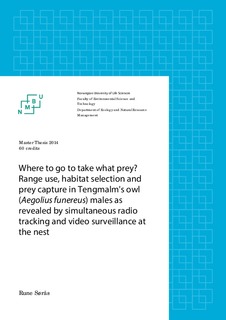| dc.description.abstract | The home range use and habitat selection of four providing male Tengmalm's owls (Aegolius funereus) were studied by using radio telemetry, and simultaneously recording prey deliveries by a video camera positioned inside the nest box of each nest. The camera allowed prey identi cation and made it possible to assign prey deliveries to locations in the eld, i.e, the last observation x before a delivery. 100% MCP home ranges averaged 219.4 ha, whereas 95% kernel home ranges had a mean size of 310 ha, and decreased with increasing proportion of high productivity areas in the home range. Owls did not shift hunting areas from one night to the next, but rather changed it gradually over time. Habitat selection was estimated by calculating the distance from each observation x (N=458) and from each random plot (N=480) to the nearest patch of each habitat class, and testing for di erences using logistic regression. The owls showed a particularly strong selection for hunting in forest age class I (clear-cuts and plantations), which is the primary habitat of their main prey, Microtus voles. They hunted closer to areas of medium and high productivity, and farther from areas of low productivity and impediment than expected by random. This may be related to abundance and availability of prey animals which select areas of dense vegetative cover. Bogs did not seem to be selected, but due to the low proportion in two of the nests, the results were inconclusive. Male owls both hunted and captured prey closer to the nest than expected by random. Additionally, prey captures were located closer to high productivity and farther from areas of impediment than expected by random. Shrews were captured closer to areas of high productivity than expected by random, which is in accordance with other ndings that suggest that the density of shrews increases with productivity. Shrews seemed to be excluded from certain habitats by Microtus voles because captures of shrews were located farther from forest age class I than captures of Microtus voles. Although the pro tability of transporting prey items back to the nest in theory is related to prey size and distance from the nest, the larger Microtus voles were not
transported to the nest from longer distances than the smaller shrews. An owl returned to the area where it captured the last prey more often than expected by random. Thus, the owls utilized a win-stay strategy. The present study is the rst to combine radio tracking and video monitoring to determine habitat speci c prey capture in Tengmalm's owl and highlight the importance of habitat productivity for hunting owls. | nb_NO |

